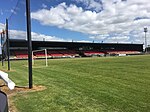Rosehill Secondary College is located in Niddrie, Victoria, Australia. In 1959, it was established as Niddrie Technical School, a single-building all-boys school. The school was renamed as 'Niddrie Secondary College' and became co-educational in the early 1990s. In 2009 it was renamed again to be 'Rosehill Secondary College', after Rosehill Road which it has a boundary on. As of 2014, the number of enrolments exceed 1,150, with many students travelling from outside Niddrie or adjacent suburbs.
Rosehill's facilities include: refurbished art rooms, visual communication and design and multimedia suite, a suite of fully equipped science rooms, a STEP learning centre which provides gifted students with the facilities to excel at higher level, purpose-built studies centres for both year 11 and year 12 students respectively, comprehensive technology facilities (materials and non-materials), a state-of-the-art computer network and first class eLearning infrastructure, a gymnasium (ECA), a weights training room, basketball and tennis courts, large Library and a middle school classroom hub.
Rosehill Secondary College is situated on the border of Essendon West and Niddrie and sits on a site elevated high above Steele Creek, with views over the Maribyrnong River Valley.
The school is a single campus with students from Years 7 to 12. The enrolment in 2014 is 1140. Girls and boys are about equal in number. Rosehill SC has International Student accreditation. The college has a balance of experienced and younger staff with three Assistant Principals, each with a discrete area of responsibility. The College runs four, 75 minute periods per day and the school is divided into a Junior School (Years 7–9) and a Senior School (Years 10–12).
In 2014, the Junior School has 650 students and the Senior School 490. All students in Years 7–9 study Math, Science and English and choose six elective subjects from Languages (Japanese or Italian), The Arts, Physical Education and Health, Humanities and Technology; also, Literacy and Numeracy Enhancement studies. All Year 10 students study English and Math (differentiated groupings), and eight electives from the KLAs and VCE subjects; also, an interdisciplinary unit on health, drug education, driver education, and Pathways into VCE and beyond. Students in Years 11 and 12 select a VCE or VCAL pathway, with the school offering careers and further education pathways to all its students.
The College employs consultants and coaches in the areas of Literacy and Numeracy and has worked closely with a network of schools in the development of the Science Curriculum as well as the more effective use of digital technologies as an instructional and learning tool. The school also provides four enrichment programs. These consist of: the Selective Talent Enrichment Program (S.T.E.P.), which provides advancement in the areas of English, Science and Mathematics, the Rosehill Accelerated Mathematics Program (R.A.M.P.), the Rosehill English Accelerated Program (R.E.A.P.) and the Victorian High-Ability Program (V.H.A.P.).







